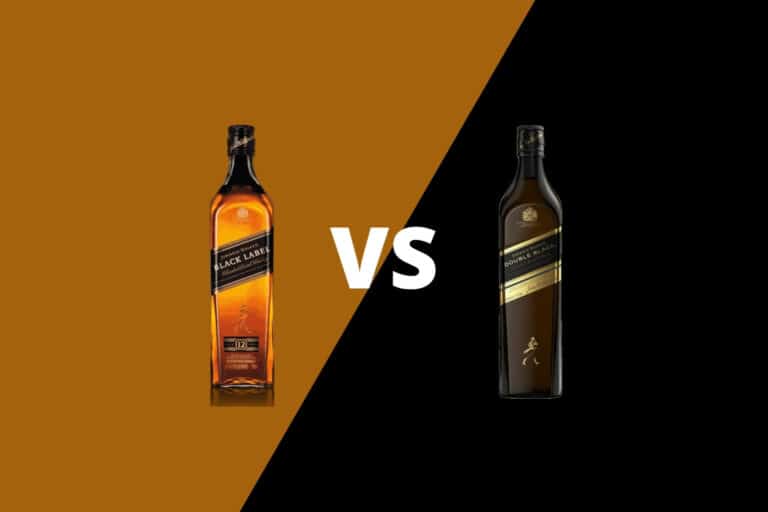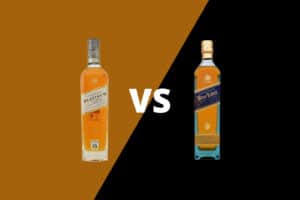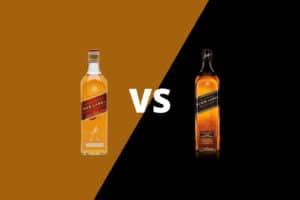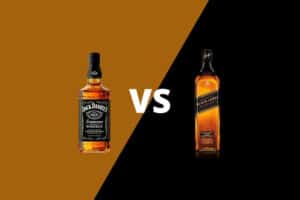None more black…
If you’ve graduated from Johnnie Walker Red Label and want to see what’s in store in the rest of the lineup, this post is the next step in your education. Read on to learn how Black and Double Black are related, how they’re different and why the brand decided to expand the lineup with this bold and smoky extension product.
Table of Contents
History
Over the years, there have been many iterations of Johnnie Walker.
In 1857, John Walker’s son, Alexander Walker, produced the first blended scotch whisky bottled under the family name — Walker’s Old Highland. This blend morphed into today’s Red and Black Label expressions when the brand launched the color-coded, tilted label on square bottle packaging with the recognizable ‘striding man’ logo we’ve all come to recognize.
Since its launch in 1909, Johnnie Walker Black Label has always carried a 12-year age statement. But Johnnie Walker Double Black is a relative baby compared to its much older siblings. It was born during the early days of the whisky renaissance that began in the 2000s. Diageo launched Johnnie Walker Double Black internationally in 2011 after a few years of targeted availability in the lucrative travel retail sector.
As American whiskey began to gain market share against scotch, the brand launched this product that offered maturation in re-charred barrels — an attribute that would likely appeal to the bourbon drinker’s fondness for the new American charred oak barrels required in bourbon production.
Mashbills
Johnnie Walker Black and Double Black are both blended whiskies, which means they contain a variety of casks containing different types of whisky blended together. Each type of whisky used in the blend is considered a component whisky. These products are a combination of single malt and grain whisky casks, nearly all of which will have been produced in the 28 distilleries across Scotland owned by Diageo.
According to Master Blender Dr. Jim Beveridge, Johnnie Walker Black and Double Black are made from the same whiskeys but in different proportions.
Maturation
One significant difference between these two brands is the use of heavily re-charred barrels. Another difference focuses on the bold flavors from single malt whiskies from West Coast and Islay whiskies.
Scotland has five predominant whisky regions, a map codified in a 2009 update to the UK’s scotch whisky regulations. Each bottle of single malt scotch produced may have one — and only one — of these regions on the label.
The five scotch whisky regions are the Highlands, the Lowlands, Speyside, Islay and Campbelltown. You may notice the West Coast is not a distinct region, but a term used to describe many parts of what was once considered ‘the Islands’ region — which was incorporated into the Highlands during the 2009 revision. Today, the West Coast, or what might also be considered the ‘Coastal West Highlands,’ include Skye, the Isle of Jura, Isle of Mull, Isle of Arran and Isle of Sky — along with other islands and the many peninsulas that jut into the Firth of Clyde, Firth of Lorn and Sea of Hebrides. In terms of flavor, exposure to crashing waves gives distilleries a salty sea brine character. And many of them incorporate peat smoke during the malting process to give the resulting whisky a decidedly smoky, medicinal, creosote character.
Let’s take a look at the Diageo map of single malt distilleries in these regions. Remember that we don’t have a complete list of casks used in Johnnie Walker Double Black. Without Master Blender Dr. Jim Beveridge walking us through a detailed cask composition for the blend, we don’t know for sure which single malts are utilized in what proportion. Furthermore, Diageo might procure casks on the secondary market that fall outside their portfolio of brands. But tasting Johnnie Walker Double Black against these single malt expressions might offer a valuable learning experience for the budding whisky aficionado looking to further their education on the category.
Diageo’s Speyside Distilleries
Caol Ila — Waves from the Sea of the Hebrides crash against the Caol Ila maturation warehouse walls and offer a distinct maritime minerality to this single malt. Although it uses the same malted barley as Lagavulin, distillation techniques reduce the phenol content of the resulting whisky, making it comparatively less smoky with floral notes.
Lagavulin — This is a dram for the peat fanatic. The Lagavulin distillery began legal distillation in 1816. Recently, Americans who love the big peat smoke flavor have made Lagavulin one of the most popular Islay brands in terms of value.
Diageo’s Coastal Distilleries
Talisker — Established in 1830 on the shores of Loch Harport on the Isle of Skye. The barrel warehouse abuts the bay, and exposure to the maritime climate, sea spray and surf give the whisky a briny character, and the use of medium peat gives it smoky notes. Five copper stills — two wash stills and three smaller spirit stills — means that in addition to relatively large capacity, Talisker can offer a depth of flavor in its single malts.
Oban — Located a few feet from the sea — 208 steps to be exact according to the website — the distillery has a considerable reputation when considering its relatively small size. It was built in 1794 and offers fruit and honey notes along with sea brine and peat.
Ownership, Price Point & Value
Johnnie Walker is produced by Diageo, the London-based drinks giant that is considered the largest distilled spirits company globally.
Johnnie Walker Black Label 12 Year Old will cost about $40 for a 750mL bottle at 40 percent alcohol by volume, or 80-proof.
Johnnie Walker Double Black will cost about $47 for a 750mL bottle at 40-percent ABV or 80-proof.
Other whiskeys in the Johnnie Walker lineup include Johnnie Walker Red Label, the introductory offering in the standard pricing segment. Red Label is the most value-priced bottling under the brand umbrella and a great introduction to the overall scotch whisky category.
Johnnie Walker Black and Double Black are next up on the pricing chart. They represent the next two rungs on the ladder for the brand and are considered part of the premium pricing tier. They offer customers who appreciate scotch a ‘step-up’ opportunity for a well-made bottle of scotch at a reasonable price.
Next, we have Johnnie Walker Green Label — a blended malt scotch whisky produced by combining single malt whiskies — no grain whisky included. The ‘single’ in ‘single malt’ refers to the requirement it must be produced in a single distiller and is not a reference to the grain bill. By combining various single malts, blended malts offer a depth and complexity difficult to achieve in a product made at one distillery. Although it is in the super-premium pricing tier, Green Label is reasonably priced at about $62 for a 15-year bottle at 86-proof.
Johnnie Walker Gold Label Reserve is a blended scotch whisky priced above Green Label in the super-premium tier. It does not offer an age statement but boasts a higher proportion of Speyside and Highland whiskies and less peat than other expressions.
Johnnie Walker Aged 18 Years is an age statement blended scotch at the high-end of the super-premium tier.
Johnnie Walker Blue Label appeals to the luxury consumer. At about $240, it is considered ultra-premium pricing and is one of the highest suggested retail prices on a widely available, nationally distributed bottle of whiskey.
John and Alexander Walker may have pioneered the ‘good, better, best’ strategy employed by most big-scale whiskey brands to this day. The current standard lineup — which includes bottles priced from about $25 to $250 — reflects the evolution of that strategy in the 21st century. As one of the most recent entrants, the Double Black bottling offers a peek into how brands think about premiumizing product lineups.
Tasting Notes
Johnnie Walker Black Label 12-Year-Old Blended Scotch Whisky
Description: In the glass, Johnnie Walker Black Label has a deep gold hue, with pronounced legs at 80-proof.
Nose: Floral rose notes, a wisp of peat, toasted oak, leather and tobacco.
Palate: Peat and charcoal notes reminiscent of a campfire, sweet wheat and malty notes, leather, tobacco, vanilla, cherries, honey and almonds.
Finish: Leather, tobacco, vanilla, cinnamon, cherries and lingering peat notes.
Johnnie Walker Double Black Blended Scotch Whisky
Description: Thanks to the heavy charring, Johnnie Walker Double Black is the darkest of the lineup. It has a copper hue and mahogany color. In the glass, it has moderate legs at 80-proof.
Nose: Medicinal creosote peat-reek, barrel char, leather, earthy notes and iodine.
Palate: Clover, an oily mouthfeel, nutty flavors, creosote, peat, oak, pepper spice.
Finish: Peat smoke, medicinal creosote, vanilla, tobacco and leather.
Verdict…
Each is a great opportunity to try a premium blend. Johnnie Walker Double Black was released as a ‘premiumized’ version of Black Label, with a $10 difference in asking price reflected in its high-end packaging.
No matter where you are on your whiskey journey, the brand’s global presence means you’ll have a hard time convincing some enthusiasts you’re a ‘scotch expert’ if you haven’t given Black Label a try. And if you find you’re a fan of the wispy peat smoke notes in Black Label, it might make sense to give Double Black a try to see if you favor the re-charred oak barrels and more pronounced smoke notes.

















